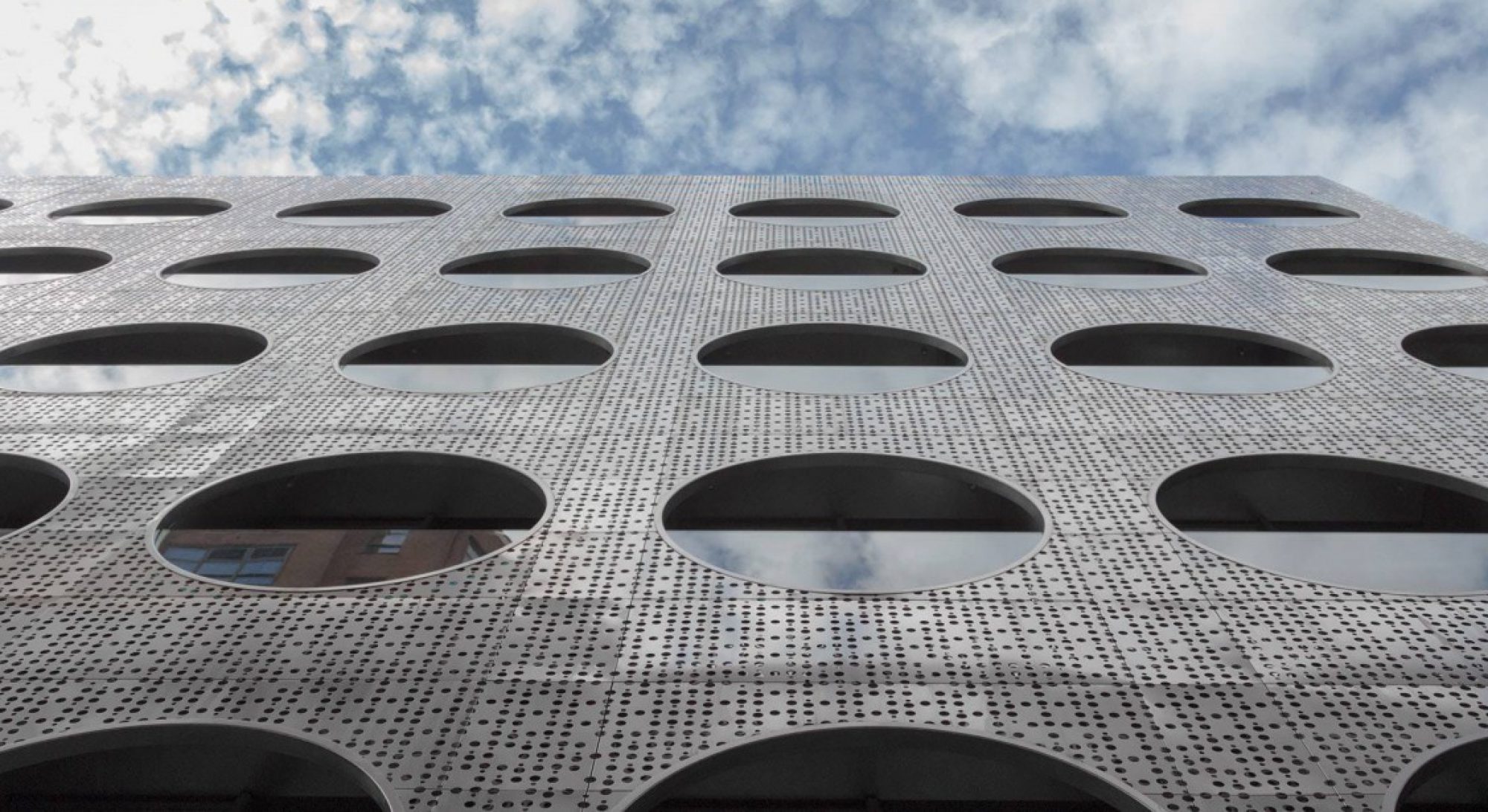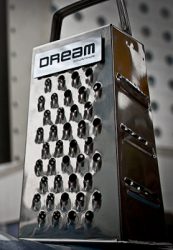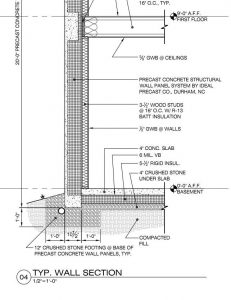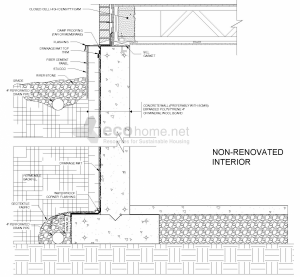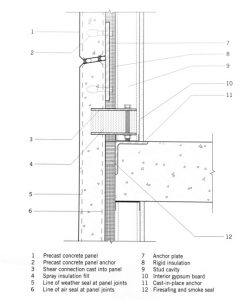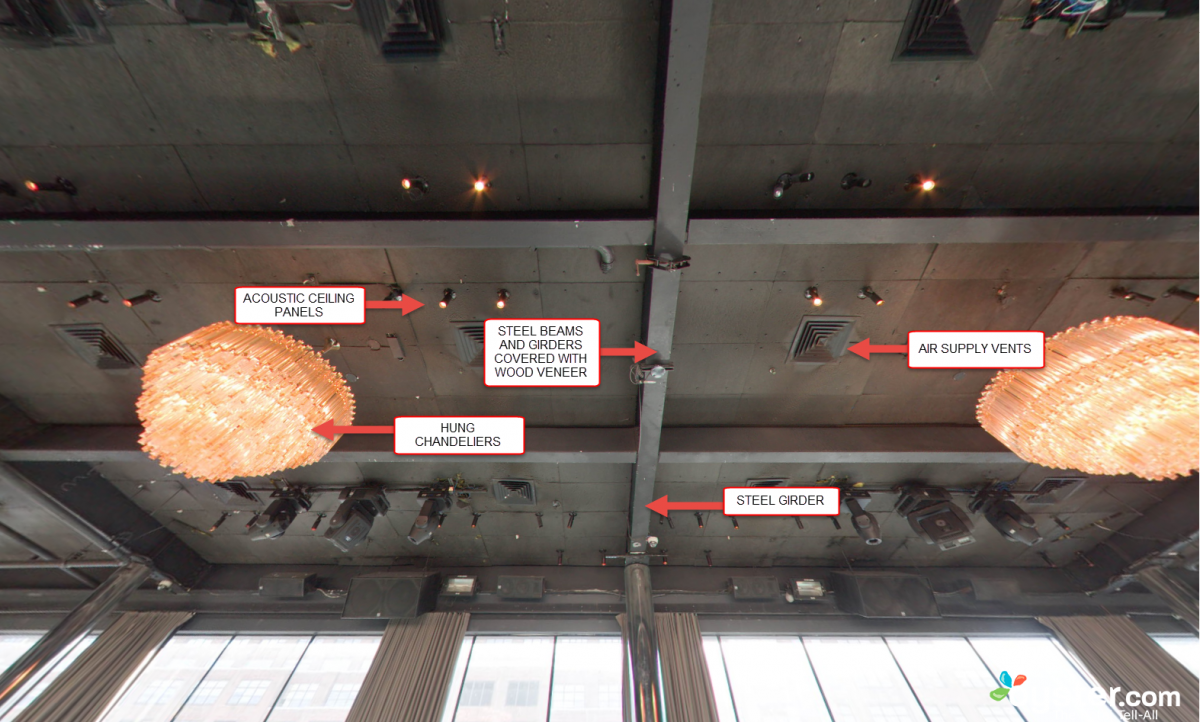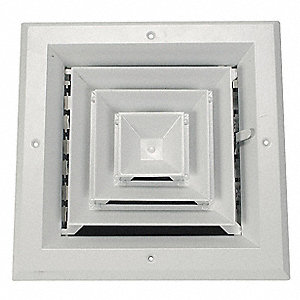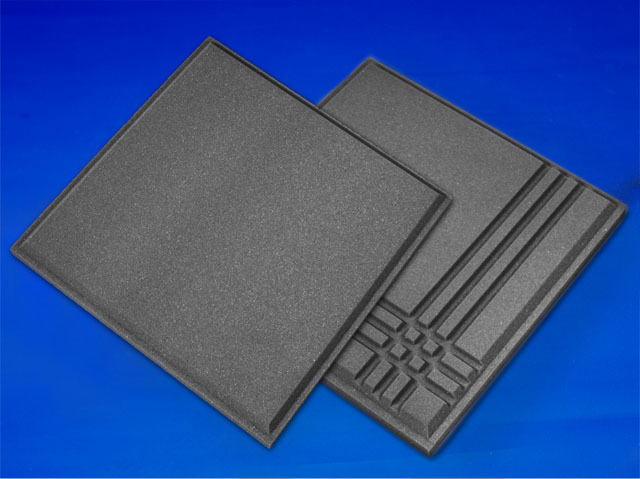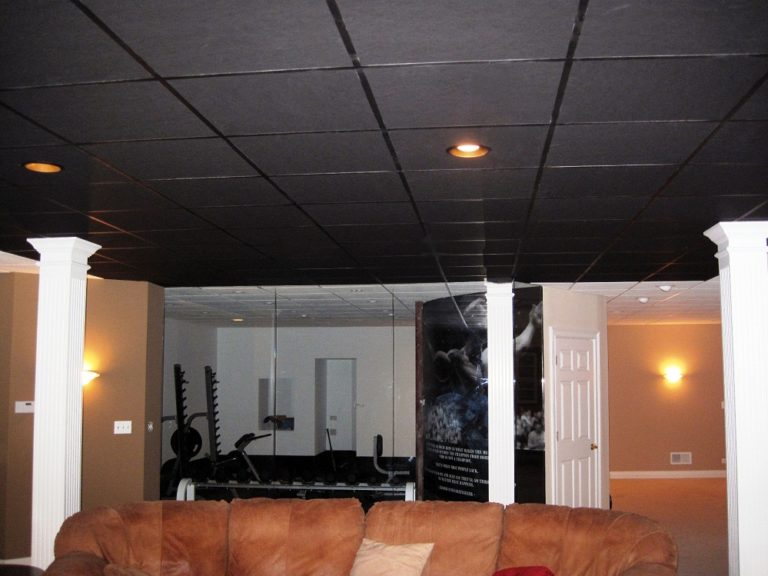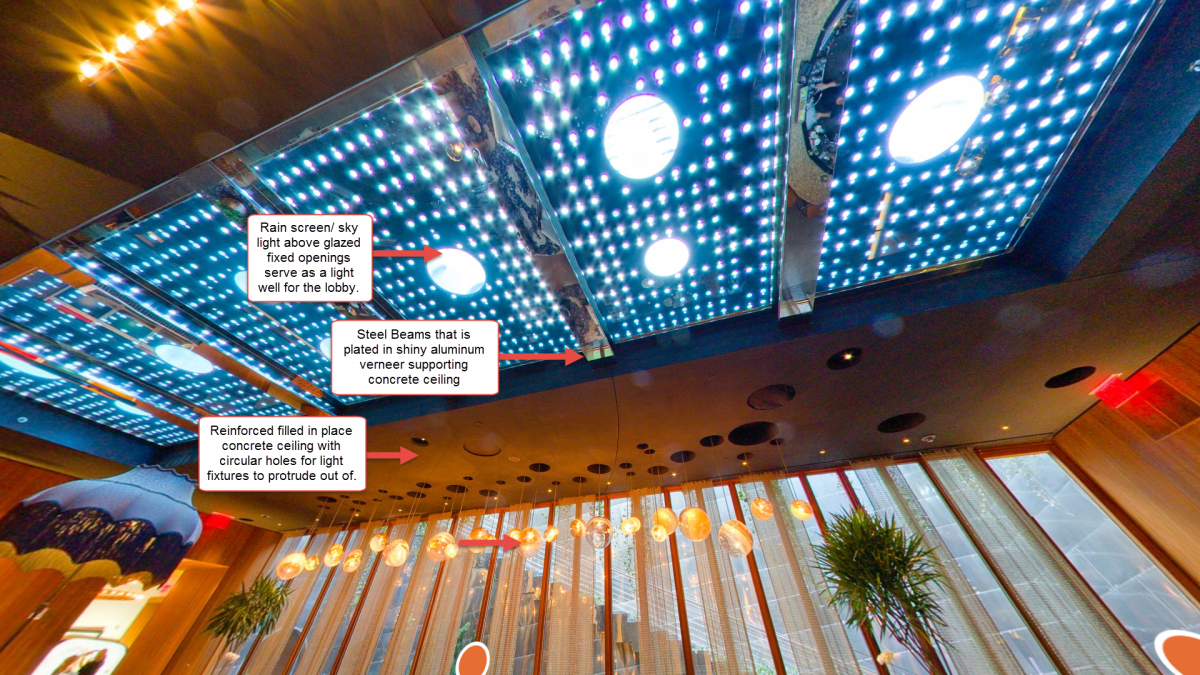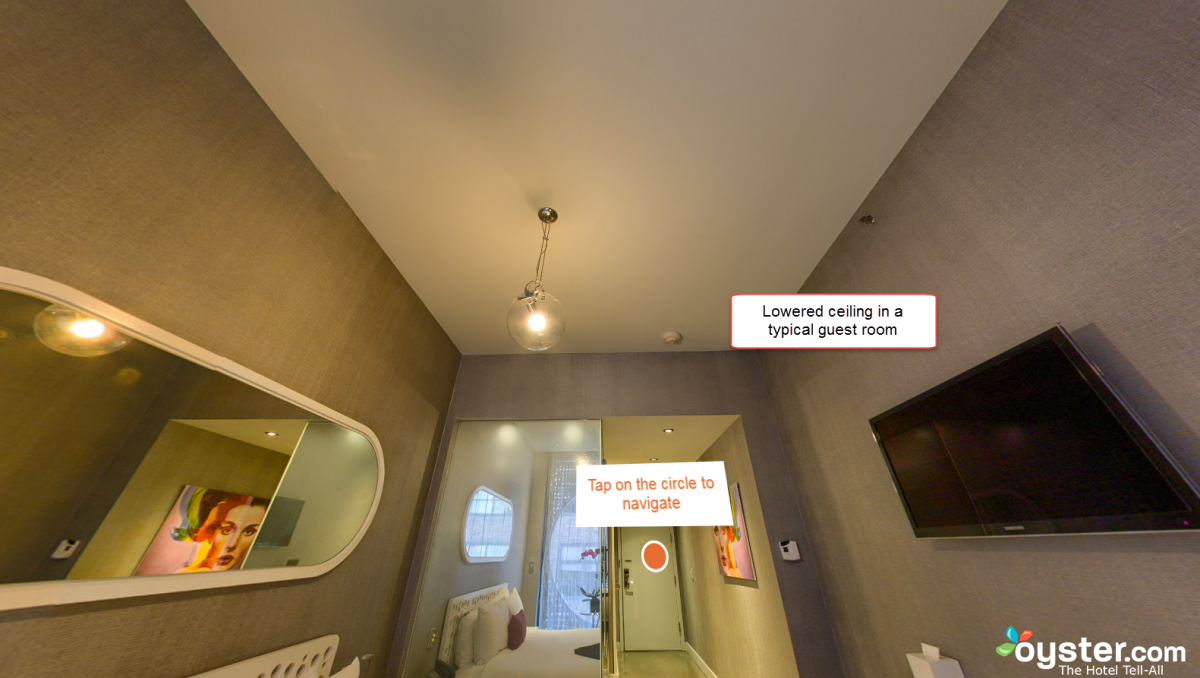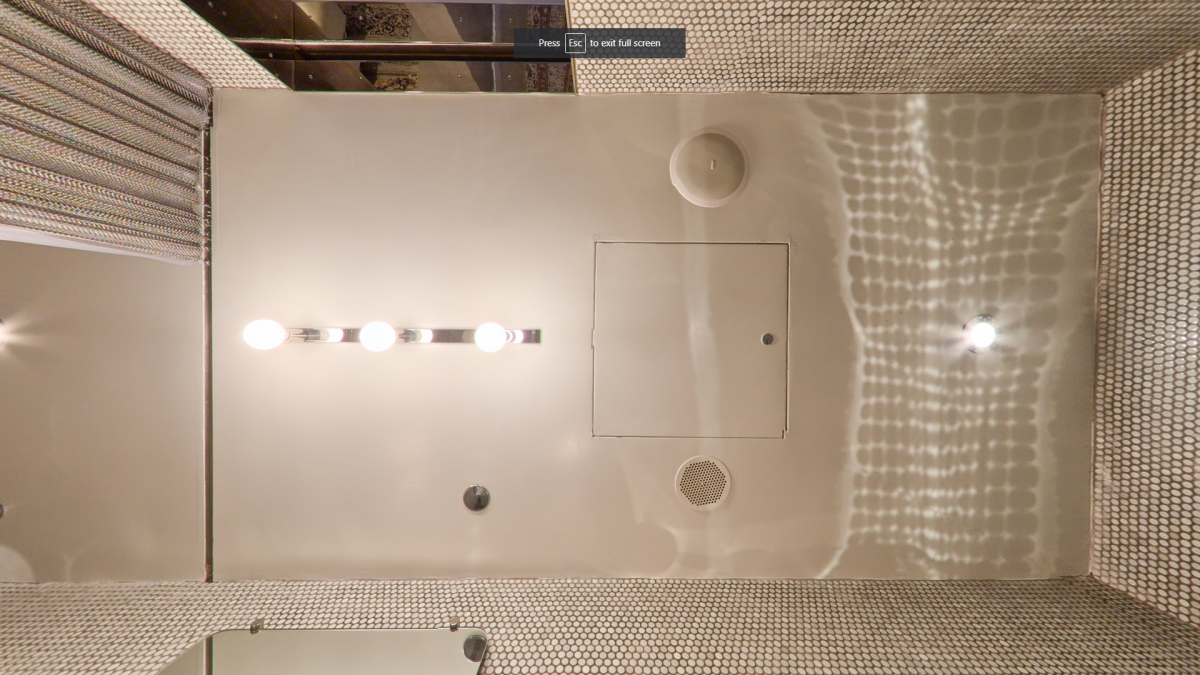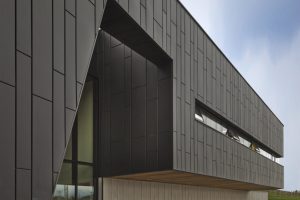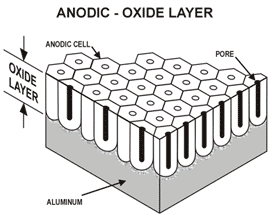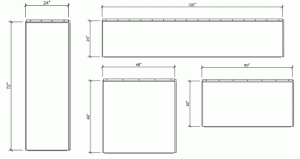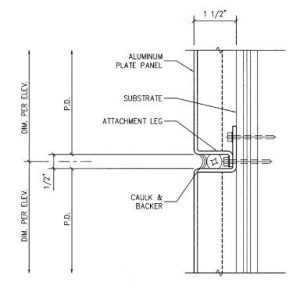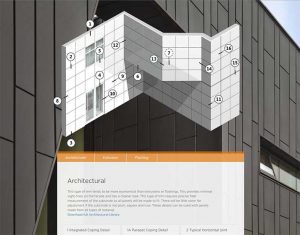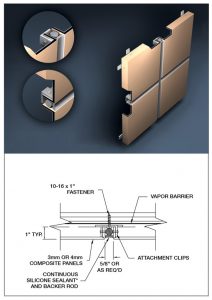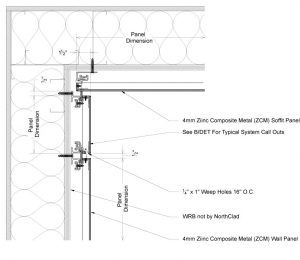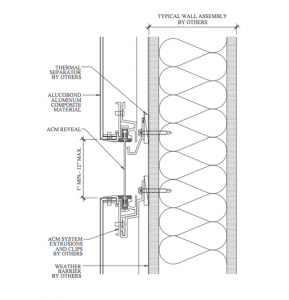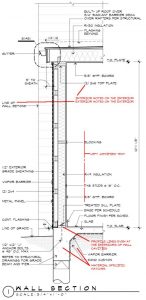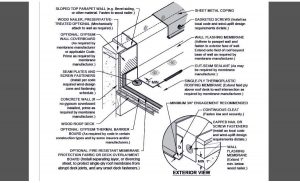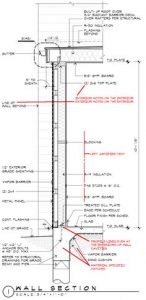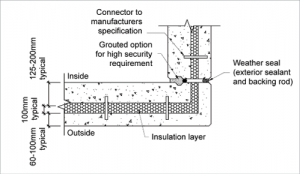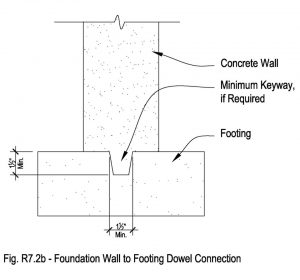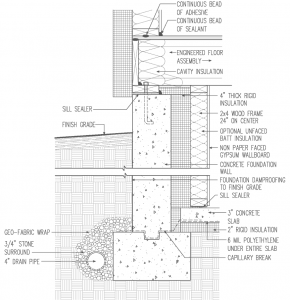Precast Concrete Wall System
From interior to exterior a precast concrete wall begins with a group of layers consisting of a ½” of gypsum wall board, a 2×4 stud wall and 2” of rigid insulation for thermal protection. This connects to a precast concrete panel through an anchor plate, bolted into the precast panel. At this point of connection two precast panels meet with backer rod and inner sealant and outer sealant for waterproofing. A concrete slab connects to precast panel by a two layers of shear connection cast into the precast panel filled with spray insulation fill. This anchored into the slab and shelf angle on the corner of the slab. Between the shelf angle and precast panel is a space for the fire safing and smoke seal to protect against fires.
CaseStudyGrid_Yocelyne_Portillo_Final_8.03
Composite Metal Panel Connections
A composite metal panel can be a “rain screen pressure equalized dry-joint system” meaning it serves to keep water out from penetrating into the building. It allows minimal water penetration where water that enters into the wall system is drained through weep holes. This wall system begins with typical wall of CMU or concrete with sheathing, a weather resistant barrier and insulation with a water barrier in front of it. The metal panel system is attached to the CMU or concrete wall by a attachment grit like an EC-203 with a fastener attached through the CMU or concrete. This piece spans along the CMU or concrete wall to attach the panels on it. The EC-203 is locked in with a EC-202, held together with a smaller fastener on both sides. The EC-202 wraps around the metal panels where two panels ends meet, each with a weep hole and weep baffle to drain out any water penetrated through the wall system. Another wall to keep water out is the use of backing rod and sealant in the wall system of about ½”. The metal panel is around 1-15/16” thick from water barrier to the exterior of the metal panel.
CaseStudyGrid_Yocelyne_Portillo_Final_8.03ec-200-details
Stainless Steel Rainscreen Panel
Stainless Steel Rainscreen Panel
Rainscreens offer many benefits for exterior wall performance and maintenance. This reliable building envelope resists the elements, and protects against air and water infiltration-provided their connectors are specified correctly.
Will we need exterior insulation?
Yes. Exterior insulation has almost become the design standard in colder climate zones from North Carolina up the East Coast over to the Pacific Northwest. One of the most significant considerations we have seen for specifying the connection of rainscreen panels to the building is the emphasis on the effectiveness of the exterior insulation, as this design approach is so popular due to building codes according to Brian Nelson, general manager at Knight Wall Systems, Deer Park, Wash.
It’s important that the rainscreen connector be easily adjustable so workers in the field can easily fine-tune the installation to achieve precision. “The beauty of a rainscreen is that the waterproofing is taken care of behind the scenes-the rhythm of the rainscreen panels is independent of the waterproofing joints,” says San Francisco-based architect Charles F. Bloszies, FAIA.
“I am more concerned with the structural components beneath the panel,” he says. “The quality of the connections you don’t see are often more important than the finished surface you do see.” says Christopher Costanza, RA, AIA, LEED AP, architect at 9X30 Design Architecture LLP, Rochester, N.Y.
Metal’s Weatherability
Open-joint rainscreen systems are designed to let limited moisture in, so architects must pay close attention to metal’s weatherability when specifying their connectors. A combination of dissimilar metal materials can cause cathodic corrosion. In some cases materials such as aluminum; will corrode if it is near dissimilar metals such as copper which leads to corrosion.
“Aluminum weathers well, as long as it’s not placed up against another dissimilar metal,” says John Barbara, AIA, LEED AP, senior associate at LEO A DALY, Washington, D.C. “If steel and aluminum are used together, a coating is needed to separate the two. Steel-only connectors need to be either coated or galvanized.
Reducing Thermal Bridging
“In a perfect world, we would use a fiberglass clip, which is a localized thermal break you attach to a hat channel,”says, Alex Terzich, AIA, of Minneapolis-based Hammel, Green and Abrahamson “But these are expensive and it’s often not in the cards for us to do that. So we look at different scenarios. Do we use intermittent Z-girts? These localized points of penetration through the insulation work well thermally, but they require a lot more layout and time. Do we use two lines of Z-girts? [They are] horizontals, with verticals on top of that, and where they cross is the one thermal bridge, which helps reduce thermal transmission. It’s a good option but also more material, more time, more cost. What we usually specify is a conventional, continuous linear Z-girt that’s bridging through the insulation, then we take that thermal bridge into account when we specify the insulation type and thickness to make sure we still meet the code-required system Uvalue requirement for the wall.”
Obviously, there are many details to rainscreen connector specification and many others not discussed in this article. Barbara believes it’s these details that often make or break a project, and bring it to the next level. “It really comes down to getting those details finessed,” he says. “The quality of the design documents is critical, but even more important is the builder’s ability to execute them, so good detailing that is buildable and resolved in the studio is essential.”
Reflected Ceiling Details and Information
NYC Stairs Building Code
“(2) The maximum vertical rise of a single flight of
stairs between floors, between landings or platforms, or
between a floor and a landing or platform, shall not
exceed eight feet in buildings classified in occupancy
groups F and H, and twelve feet in all other occupancy
groups. No flight of stairs shall have less than two risers.”
http://www.nyc.gov/html/dob/downloads/bldgs_code/bc27s6.pdf
“1009.7
Anodize Aluminum Paneling
WHATS IS ANODIZING?
It is an electrochemical process that converts the metal surfaces into decorative, durable, corrosion- resistance, anodic oxide finish.
DRI DESIGN
SLOGAN :
“NO SEALANTS, GASKETS OR BUTYL TAPE IN THE PANEL JOINTS MEAN NO DIRTY STREAKS OR MAINTENANCE.”
Anodize Aluminum Panels:
Overview:
Successfully combines science and nature to create a great form of metal finish. The dense surface of the Aluminum is created utilizing the natural oxidation process and adding electricity and chemical to enhance the process and well as the outcome. This Aluminum process bring out the natural variation in colors which is expected.
PANEL INFO
Specification:
System Dimension: 1-1/4” Nominal
Material: Aluminum
Material Thickness: .08” standard (other gauges available)
Panel Joint: ½” Nominal Standard (1/8” to 1”)
Finish: Clear, Bronze, Champagne, and Black Anodizes
Weight: Less than 2 pounds per square foot
PRO:
- Exceptional abrasion Resistance, corrosion, chemical and solvents.
- Cost efficient
- Available in one-part or two-part panels.
- The anodize panel reveals the natural beauty of Aluminum while enhancing it strength and it aesthetic abilities.
CONS:
- Requires special processes to be welded.
- Prone to sever spring break.
- Abrasive to tooling.
Team Member Materials
Tom:
- (Image Wall) Perforated Stainless Steel Rainscreen
- Stick Glass Curtain Wall system
Yocelyne:
- Metal Panel Wall
- Concrete Wall
Chandanie:
- Anodized aluminum wall
- Brick veneer wall
Metal Panel Walls
WALL PANEL: A non-structural element that forms a curtain wall with loads transferred from the wall panel to a structural frame.
WALL PANEL ADVANTAGES: The cost and maintenance is low for metal wall panels since there is possibilities for customization and availability. It is quick and easy to install and there is a small amount of scrap after it is installed. Its lifespan is from 20 to 40 years and doesn’t require as much replacement as other wall systems. They are strongly resistant to fire so insurance cost is lower for metal panels and lower cost of utility since they are insulated to resist heating and cooling. If constructed right, the metal panel seams help keep water out. Another great benefit is its lightness compared to materials like brick. It is also sustainable and energy efficient because it can be 100% recycled and still remains strong as its original state.
COMPOSITE WALL PANELS
https://www.pac-clad.com/products/wall-panels/composite-wall-panels/
INSULATED METAL PANEL
http://fmlink.com/articles/metl-span-white-paper-lists-benefits-of-insulated-metal-panels/
https://www.pinterest.com/pin/444660163193234017/
http://northclad.com/products/zn/zinc-composite/details/
https://www.pinterest.com/pin/445363850624923973/
https://www.pinterest.com/pin/479140847849370601/
TRADITIONAL METAL PANEL(SECTION)
A traditional metal panel system is connected to a metal wall stud. On the exterior of this wall system is the metal panel and on the interior is a piece of gypsum board. In between these two is a layer of air permeable waterproofing. Then there is a sheathing layer and stud cavity insulated with batt insulation. Following the batt insulation and metal studs is a vapor barrier/air barrier to block off moisture from entering the wall.
Concrete Wall (Research)
Concrete Walls can be constructed from precast concrete, poured concrete, concrete block, stucco concrete, stamped concrete and colored concrete. Precast walls can be reinforced with steel ribs. Poured concrete walls can be used for a foundation or as a retaining wall. Concrete block walls can also be used in a foundation or as a retaining/decorative wall. Stucco walls serve more as texture. It is made of a thin concrete layer that is used over an existing wall. Stamped walls are similarly created to poured concrete walls in the way it is molded. Colored concrete walls also are created by poured concrete techniques.
https://www.pinterest.com/pin/795870565369065360/
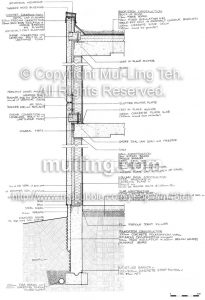
http://www.lifeofanarchitect.com/graphic-standards-part-2/
http://www.yourhome.gov.au/materials/precast-concrete
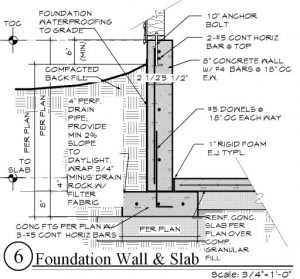
http://www.greenbuildingadvisor.com/blogs/dept/musings/foam-under-footings
